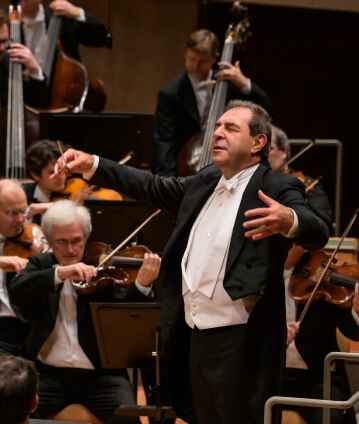Daniele Gatti conducts Brahms, Stravinsky and Webern

Clara Schumann wrote effusively about the “mysterious magic of life in the forest” that she felt when listening to Brahms’s Third Symphony. And, over long stretches, the work does indeed seem like a musical representation of idyllic nature. Brahms combines folk song-like melodies with a rich sound world. This inspired the young Anton Webern to write his wistful Langsamer Satz. Igor Stravinsky, on the other hand, modelled his Symphony in C on the First Viennese School. The result is a fresh new interpretation of musical traditions.
Anton Webern’s Langsamer Satz for string quartet was composed when he was just starting his studies with Arnold Schoenberg. The composition, which was only rediscovered in the 1960s, is characterised by an impassioned, expressive style reminiscent of early Schoenberg or Wagner’s Siegfried Idyll. However, the late Romantic tone is also attributable to a personal experience: at the time the work was written, Webern had fallen in love with his cousin Wilhelmine, who later became his wife.
The late 1930s were a particularly turbulent and difficult time for Igor Stravinsky. His first wife and daughter died of tuberculosis, and the outbreak of the Second World War prompted the composer to emigrate to the United States. The Symphony in C, which Stravinsky wrote in 1940 in transit between continents, as it were, gives no indication of these biographical events. During this creative period, the composer was convinced of the primacy of the purely musical form over emotional expression. The four-movement work, whose captivating Larghetto concertante features solo passages for individual instruments, is the most Classical of Stravinsky’s five symphonies, each of which is stylistically very different.
Johannes Brahms also felt bound to the symphonic model of the First Viennese School, yet each of his four contributions to the genre takes on a form all of its own. The Third Symphony spans a wide arc from the first to the last bars: the opening theme of the first movement, shifting between major and minor, reappears at the end of the finale – here in a decisively major key. It begins with the notes F-A-F, with the words “Frei, aber froh” (free, but happy) assigned to them; a variation on the motto F-A-E, “frei, aber einsam” (free, but lonely). The latter was the shared motto of Brahms and his close friend, the violinist Joseph Joachim, in their youth. However, while Joachim married twice, Brahms remained a bachelor throughout his life.
© 2025 Berlin Phil Media GmbH
Related interviews
Artists
Our recommendations
- Daniele Gatti conducts Hindemith and Brahms
- Daniele Gatti conducts masterworks of French modernism
- Daniele Gatti conducts Schoenberg, Strauss and Wagner
- Daniele Gatti conducts Stravinsky and Shostakovich
- Daniele Gatti’s journey from the Romantic to the modern era
- Daniel Barenboim conducts Verdi’s Requiem